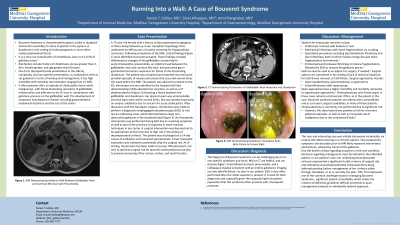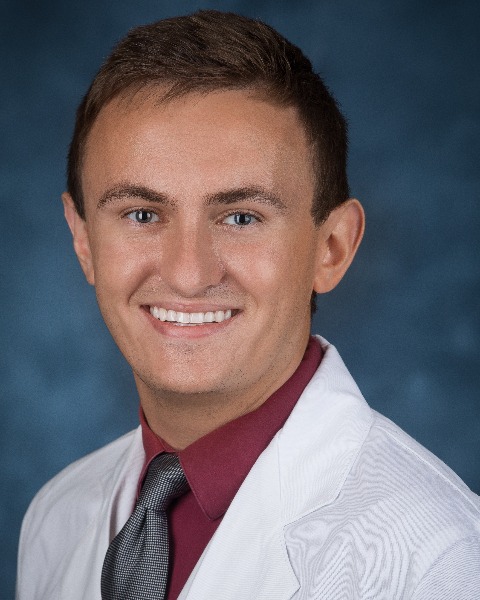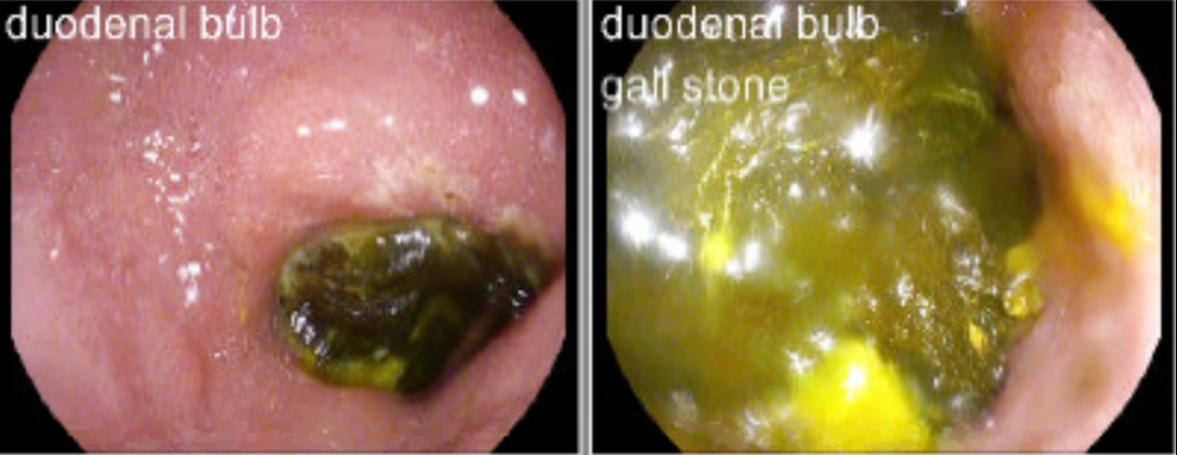Back


Poster Session D - Tuesday Morning
Category: Small Intestine
D0644 - Running Into a Wall: A Case of Bouveret Syndrome
Tuesday, October 25, 2022
10:00 AM – 12:00 PM ET
Location: Crown Ballroom

Has Audio

Daniel Gildea, MD
MedStar Georgetown University Hospital
Washington, DC
Presenting Author(s)
Daniel Gildea, MD, Dalal Alhaqqan, MD, Amol S. Rangnekar, MD
MedStar Georgetown University Hospital, Washington, DC
Introduction: Bouveret syndrome is characterized by gastric outlet or duodenal obstruction due to stone impaction in the pylorus or duodenum in the setting of cholecystogastric or most commonly cholecystoduodenal fistula. It is a very rare complication of cholethiasis, seen in 0.3-0.5% of cases.1 Due to its disproportionate presentation in the elderly, complexity, and non-specific presentation in combination with no set workup or management guidance, it has mortality rates ranging from 12-30%.1
Case Description/Methods: A 75 year-old female with a history of decompensated cryptogenic cirrhosis underwent routine MRI HCC screening, which identified signs of cholecystitis, pneumobilia, and fistula between the gallbladder and duodenum. The patient reported a postprandial “gallbladder attack” with epigastric/RUQ pain and nausea one week prior to MRI, with intermittent smaller attacks since. She was advised to present to the ED, where her exam was normal and labwork mildly cholestatic. CT abdomen/pelvis recapitulated the MRI findings. She underwent EGD, which demonstrated a large non-obstructive gallstone in the duodenal bulb. Due to resolving symptoms and lack of expertise in stone removal, no endoscopic intervention was performed. The patient was deemed too high-risk for surgery given her cirrhosis. She was discharged on antibiotics, and is currently planned for TIPS for risk optimization.
Discussion: This rare case was discovered via routine HCC MRI screening. The postprandial symptoms described likely represent intermittent obstructions, relieved by gallstone transit. While there are no guidelines for Bouveret syndrome management, strategies have developed. Management starts with diagnosis, usually via CT or MRI.2 EGD for diagnostic and sometimes therapeutic purposes is then performed. Endoscopic removal options include baskets or nets, mechanical lithotripsy, and specialized procedures including electrohydraulic, shockwave, or laser lithotripsy.2 Surgical options are considered for lack of endoscopic technical expertise or EGD failure. Cholecystectomy with fistula repair is controversial; often it cannot be performed due to comorbidity and risk, leaving patients at risk for recurrence and even malignancy related to the unremoved fistula.2 In our patient’s case, her cirrhosis represented a hurdle in terms of surgical risk. In the end, the dearth of data regarding outcomes in this rare condition makes creating definitive guidelines difficult, and pushes management towards an individually-tailored approach.

Disclosures:
Daniel Gildea, MD, Dalal Alhaqqan, MD, Amol S. Rangnekar, MD. D0644 - Running Into a Wall: A Case of Bouveret Syndrome, ACG 2022 Annual Scientific Meeting Abstracts. Charlotte, NC: American College of Gastroenterology.
MedStar Georgetown University Hospital, Washington, DC
Introduction: Bouveret syndrome is characterized by gastric outlet or duodenal obstruction due to stone impaction in the pylorus or duodenum in the setting of cholecystogastric or most commonly cholecystoduodenal fistula. It is a very rare complication of cholethiasis, seen in 0.3-0.5% of cases.1 Due to its disproportionate presentation in the elderly, complexity, and non-specific presentation in combination with no set workup or management guidance, it has mortality rates ranging from 12-30%.1
Case Description/Methods: A 75 year-old female with a history of decompensated cryptogenic cirrhosis underwent routine MRI HCC screening, which identified signs of cholecystitis, pneumobilia, and fistula between the gallbladder and duodenum. The patient reported a postprandial “gallbladder attack” with epigastric/RUQ pain and nausea one week prior to MRI, with intermittent smaller attacks since. She was advised to present to the ED, where her exam was normal and labwork mildly cholestatic. CT abdomen/pelvis recapitulated the MRI findings. She underwent EGD, which demonstrated a large non-obstructive gallstone in the duodenal bulb. Due to resolving symptoms and lack of expertise in stone removal, no endoscopic intervention was performed. The patient was deemed too high-risk for surgery given her cirrhosis. She was discharged on antibiotics, and is currently planned for TIPS for risk optimization.
Discussion: This rare case was discovered via routine HCC MRI screening. The postprandial symptoms described likely represent intermittent obstructions, relieved by gallstone transit. While there are no guidelines for Bouveret syndrome management, strategies have developed. Management starts with diagnosis, usually via CT or MRI.2 EGD for diagnostic and sometimes therapeutic purposes is then performed. Endoscopic removal options include baskets or nets, mechanical lithotripsy, and specialized procedures including electrohydraulic, shockwave, or laser lithotripsy.2 Surgical options are considered for lack of endoscopic technical expertise or EGD failure. Cholecystectomy with fistula repair is controversial; often it cannot be performed due to comorbidity and risk, leaving patients at risk for recurrence and even malignancy related to the unremoved fistula.2 In our patient’s case, her cirrhosis represented a hurdle in terms of surgical risk. In the end, the dearth of data regarding outcomes in this rare condition makes creating definitive guidelines difficult, and pushes management towards an individually-tailored approach.

Figure: EGD Demonstrating Gallstone in the Duodenal Bulb
Table: Table of References
Disclosures:
Daniel Gildea indicated no relevant financial relationships.
Dalal Alhaqqan indicated no relevant financial relationships.
Amol Rangnekar indicated no relevant financial relationships.
Daniel Gildea, MD, Dalal Alhaqqan, MD, Amol S. Rangnekar, MD. D0644 - Running Into a Wall: A Case of Bouveret Syndrome, ACG 2022 Annual Scientific Meeting Abstracts. Charlotte, NC: American College of Gastroenterology.
